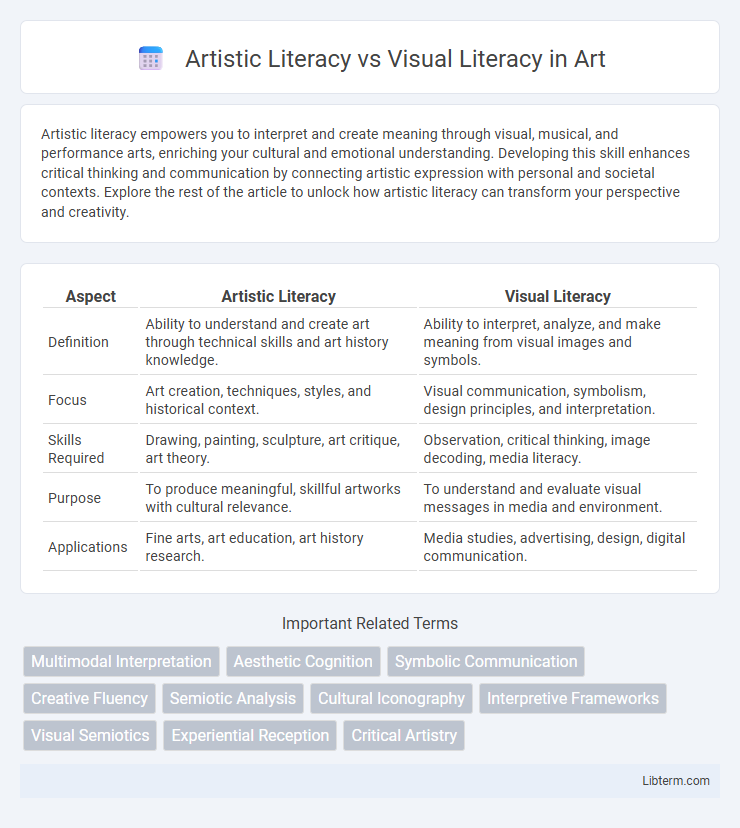Artistic literacy empowers you to interpret and create meaning through visual, musical, and performance arts, enriching your cultural and emotional understanding. Developing this skill enhances critical thinking and communication by connecting artistic expression with personal and societal contexts. Explore the rest of the article to unlock how artistic literacy can transform your perspective and creativity.
Table of Comparison
| Aspect | Artistic Literacy | Visual Literacy |
|---|---|---|
| Definition | Ability to understand and create art through technical skills and art history knowledge. | Ability to interpret, analyze, and make meaning from visual images and symbols. |
| Focus | Art creation, techniques, styles, and historical context. | Visual communication, symbolism, design principles, and interpretation. |
| Skills Required | Drawing, painting, sculpture, art critique, art theory. | Observation, critical thinking, image decoding, media literacy. |
| Purpose | To produce meaningful, skillful artworks with cultural relevance. | To understand and evaluate visual messages in media and environment. |
| Applications | Fine arts, art education, art history research. | Media studies, advertising, design, digital communication. |
Understanding Artistic Literacy: Definition and Scope
Artistic literacy encompasses the ability to interpret, create, and critically analyze various forms of art, including painting, sculpture, music, and theater, emphasizing cultural, historical, and emotional contexts. It involves understanding artistic techniques, symbolism, and the artist's intent to foster deeper appreciation and meaningful engagement with artworks. This broad scope contrasts with visual literacy, which specifically focuses on the interpretation and communication of visual images and their design elements.
Visual Literacy Explained: Key Concepts and Elements
Visual literacy involves the ability to interpret, negotiate, and make meaning from information presented in the form of images, encompassing key concepts such as composition, color theory, and symbolism. It requires understanding visual elements like line, shape, texture, space, and value to decode messages embedded within visual media effectively. Mastery of visual literacy enhances critical thinking and communication skills by enabling individuals to analyze and create visual content with purpose and clarity.
Core Differences Between Artistic Literacy and Visual Literacy
Artistic literacy involves understanding and interpreting the cultural, historical, and emotional contexts of artworks, requiring knowledge of art history, symbolism, and artistic techniques. Visual literacy centers on the ability to decode, evaluate, and create meaning from visual information such as images, symbols, and visual media, emphasizing perceptual skills and visual communication strategies. The core difference lies in artistic literacy's focus on critical analysis of art as cultural expression, while visual literacy prioritizes functional interpretation and effective use of visual elements in various contexts.
The Historical Evolution of Artistic and Visual Literacy
Artistic literacy evolved through centuries as societies developed symbolic languages and traditional art education emphasized mastery of techniques and cultural narratives. Visual literacy emerged in the 20th century alongside technological advancements, emphasizing the interpretation and critical analysis of images in media and communication. The historical evolution reflects a shift from creating and appreciating art to decoding visual information in increasingly image-saturated environments.
Essential Skills Developed Through Artistic Literacy
Artistic literacy develops essential skills such as creative thinking, emotional expression, and cultural awareness by engaging individuals in art creation and interpretation. It enhances the ability to analyze symbolic meaning, understand artistic techniques, and communicate complex ideas visually and verbally. These skills foster deeper cognitive and emotional connections, differentiating artistic literacy from visual literacy, which primarily emphasizes the ability to interpret images and visual media.
Visual Literacy in the Age of Digital Media
Visual literacy in the age of digital media emphasizes the ability to interpret, analyze, and create meaning from images across diverse digital platforms. The proliferation of multimedia content, social media, and virtual reality requires heightened skills in decoding visual symbols, understanding design principles, and recognizing visual rhetoric. Mastering visual literacy enhances critical thinking and communication in a culture increasingly dominated by visual information.
The Role of Artistic Literacy in Education and Personal Expression
Artistic literacy encompasses the ability to interpret, create, and appreciate art, fostering critical thinking and emotional intelligence in educational settings. This skill empowers students to express complex ideas and personal experiences through various artistic mediums, enhancing self-awareness and communication. Integrating artistic literacy into curricula supports cognitive development and cultural understanding, making it essential for holistic education and personal growth.
Assessing Visual Literacy: Tools and Techniques
Assessing visual literacy involves evaluating the ability to interpret, analyze, and create visual content through tools such as visual comprehension tests, image-based problem-solving tasks, and digital media analysis software. Techniques include qualitative methods like focus group discussions and rubric-based assessments to measure understanding of visual elements, symbolism, and spatial relationships. Leveraging eye-tracking technology and user interaction metrics further enhances the precision in assessing how individuals process and respond to visual stimuli.
Enhancing Creativity: Integrating Artistic and Visual Literacy
Integrating artistic literacy with visual literacy cultivates enhanced creativity by enabling individuals to interpret, analyze, and produce meaningful visual and artistic content. This combination deepens understanding of symbolism, composition, and cultural context, enriching creative expression across various mediums. Developing skills in both literacies fosters innovative problem-solving and imaginative thinking crucial for artistic and design-based disciplines.
Future Trends: The Convergence of Artistic and Visual Literacies
Emerging technologies such as augmented reality and AI-driven design tools are accelerating the convergence of artistic literacy and visual literacy, enabling more immersive and interactive creative experiences. Educational frameworks are evolving to integrate these literacies, emphasizing critical analysis, digital fluency, and cross-disciplinary collaboration to prepare learners for future visual communication challenges. This fusion of skill sets drives innovation in fields like digital media, advertising, and virtual environments, where interpreting and creating complex visual narratives is essential.
Artistic Literacy Infographic

 libterm.com
libterm.com